Hydrangea macrophylla 'Blue Wave' - On Schedule
Thursday, August 07, 2008
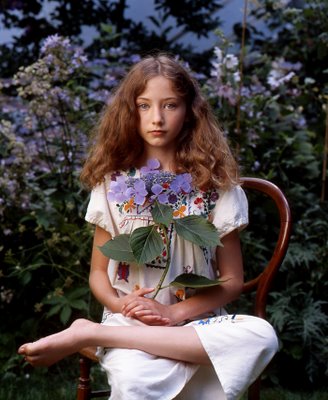 "They are early this year, " some people say of this plant or that one. The fact is that most plants open on schedule unless an extra cold winter kills them. Our Casablanca lilies bloom every year around now and they are doing just that, now. A plant's schedule can be frustrating, almost sad. I will now have to wait until next June to see and smell my once blooming Rosa 'Charles de Mills'. Thankfully some roses persist and today (I write this on Wednesday afternoon) was able to take pictures with Lauren (with the slash on her forehead covered by a Hello Kitty band-aid) and Rosa 'The Fairy', Mary Webb and L.D. Braithwaite. Tune in on Friday or Saturday to see them.  The photographs of Rebecca with various hydrangeas that I took some days ago had to wait until today as the folks at G. King Photo ran out of nitrogen gas. Nitrogen is the inert gas used in the processing of my Ektachromes. I had to wait from August 2004 to August 2008 to be able to display here the two pictures of Rebecca with Hydrangea macrophylly 'Blue Wave'. When I am am 70 I hope to be around to show similar shots of Lauren like the ones I took today with the very same plants. They are more likely to be around as they are mostly always on schedule.
Spanish On My Window Sill
Wednesday, August 06, 2008
 alféizar. (Del ár. hisp. *alḥáyza, y este del ár. clás. ḥā'izah, la que toma posesión). 1. m. Arq. Vuelta o derrame que hace la pared en el corte de una puerta o ventana, tanto por la parte de adentro como por la de afuera, dejando al descubierto el grueso del muro. 2. m. Arq. Rebajo en ángulo recto que forma el telar de una puerta o ventana con el derrame donde encajan las hojas de la puerta con que se cierra. Real Academia Española © Todos los derechos reservados One of the results of the Spanish American War (1898) that directly influenced my family on my mother's side who all lived in Manila is that the Philippines became an American protectorate. But it took a while as guerrilas fought the Americans in a pratracted and bloody insurgence. My grandfather Don Tirso de Irureta Goyena was a lawyer who in his short life (he died in his 30s of a heart attack shortly after climbing the beautiful volcano, Mayón) did everything to try to defend his beloved Spanish language from the encroachment of American English. But he did not loathe the Americans, just their language.  It seems that a particular American judge was his friend, my grandmother used to tell me. Civil proceedings at court were all held in English so my grandfather used a translator in his litigations. Many a time, my grandmother loved telling me, "Your grandfather would stop and tell the judge that the translator had it all wrong and that he had said something else. And then he would correct him." The judge would then smile at Tirso and say, "Tirso you speak perfect English, you don't need a translator. Let's stop this charade." His pleas were to no avail and Tirso gave lectures all over Manila and in Spain in defense of his beloved Spanish. He even wrote a book. His efforts were rewarded with membership (rare for a colonial or creole not born is Spain) in the Real Academia Española. For many years the huge diploma hung in my house over a wall in the picture seen here with my grandmother the day of my first communion. While in Mexico in the middle 70s my uncle Tony (Tirso's son) took the diploma over my protest and I never saw it again.  Last night I began Carlos Ruiz Zafón's El Juego del Ángel . Like his other novels and in particular La Sombra del Viento it is set in early 20th century Barcelona. His books are easy to read but I take longer than usual to read them because I savour his use of the Spanish language. A word, which means window sill in English, alféizar caught my eye. I began to dream on how the word came into the Spanish and wondered if my grandfather would have used it or noticed its beautiful sound. After all ojalá which is the word we voice to mean I hope comes from the Arabic and it means if Allah wills.
Diplolepis rosae
Tuesday, August 05, 2008
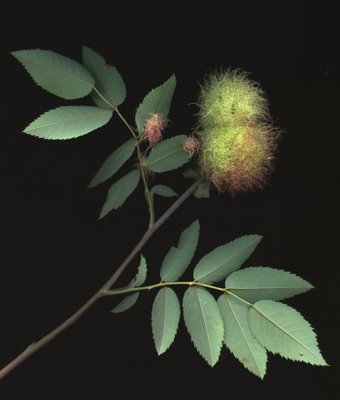 As Rosemary and I worked in the garden we talked about the sadness of taking care of a garden after a couple of open gardens (the Ballet BC Home & Garden and the Vancouver Rose Society). If we had a large family the family would come and we would have garden parties. But we are lucky that Rebecca, Lauren and their mother Hilary do come on Saturdays. While the little girls are interested in the garden, Hilary sees it in much the same way I would a row of used office furniture. Rebecca brings the rose catalogue/manual I gave her and she is interested in my roses and in hers. There is some passion there. But when Rosemary and I are alone in the garden removing the collapsed plants of late summer there is little joy. We are already looking at plants that have to be moved or plants that we have to get rid of (a tough thing it is). While pruning I noticed the interesting galls in one of our two Rosa glaucas. Of this rose I wrote here. I was telling Rosemary that in a garden with little room left there is no need to have two of them. One is in her perennial bed and the second one (a very large specimen) by the boulevard where it thrives in spite of the shade. It is this second specimen that has the galls. This time around I was determined to find out exactly what they were. The gall wasp or Diplodepsis rosae is the culprit. I have scanned one of the more interesting branches but I don't know if I am daring enough to cut them in half to see what is inside. Perhaps I can get Rebecca involved in this. She loves bugs. For more on the gall wasp read here. Or if lazy, the interesting stuff reads like this: Gall wasps are in the family Cynipidae, order Hymenoptera, class Insecta, phylum Arthropoda. Gall wasps are small (only a few millimetres long), dark-coloured insect with a compressed abdomen. Most gall wasps form galls, though a few live within the galls formed by other species; these are called inquilines. Others feed on gall-formers and inquilines.
The exact reactions which lead to gall formation in the host plant are little understood. Basically it is a reaction of the cells of the plant to the presence of the larva.
Rose galls are produced by Diplolepis rosae. These gall wasps usually reproduce asexually; the females are about 4 mm/0.2 in long; parts of their abdomens and legs are yellow-red, while the rest of the body is black. Males of this species have been observed only rarely. The galls are a mass of reddish filaments within which are found a number of sealed chambers enclosing larvae. The larvae feed on the gall tissue. © Research Machines plc 2005 What I found interesting is that the gall is not always occupied by the gall wasp but by other wasps and or insects called inquilines. In Spanish the word inquilinos is what you call renters who do not own the house they live in. 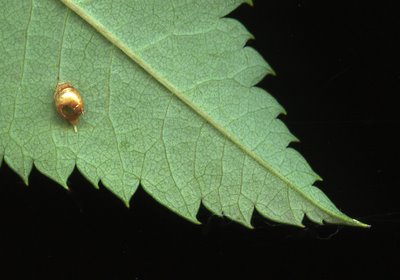 The beauty of the rose wasp gall is further enhanced at this time of the year by the large racemes of rose hips. Rosa glauca's hips may not be as large as those in other roses but they are certainly plentiful. While the ones here remind me of small tomatoes, as they age the colour begins to resemble the colour of a Hershey bar. An added bonus when I scanned the gall was the little gold point on the bottom right leaf. You can see it if you look closely at the first image. It enlarges if you click on the image. I further scanned that tip to reveal some sort of sucking insect. As to why the gall wasp "rents" the boulevard Rosa glauca, and no other roses in my garden I have no inkling. 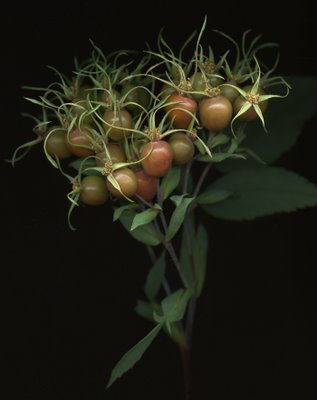
Miss Jekyll Is A True Companion
Monday, August 04, 2008
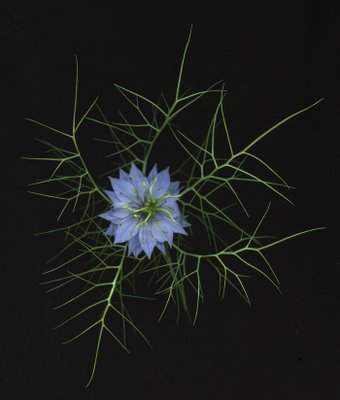 In years past Rosemary and I have seen many gardens in garden tours and conventions of the American Hosta Society. In the latter, in particular, the gardens have been "museum" gardens in which one genus (hosta) is featured with a few token companions. My friend W. George Schmid has no stomach for such a garden and neither do we. We stress the idea of companion plants. In some cases the companions can userp their role. Such is the case in one of my hosta beds where the ferns and astilbes now trumpet their delights at the expense of my hostas which are languishing in the shadows. There is nothing worse than a true rose garden. A garden that is a monoculture with stacks and rows of roses. "The hybrid teas are here and Pemberton's Hybrid Musks there," the owner of such a garden might say. There is nothing worse than a museum garden that attempts to impart a further human logic of order. In a spirit to prevent that very thing Rosemary has put energy for years in finding companions for our circular centre rose bed (it is the sunniest spot in our garden). Rosemary has succeeded with bronze fennel, Foeniculum vulgare 'Purpureum', assorted lavender and one of my favourite perennials that reminds me of Argentina. Verbena bonariense . This tall spindly plant has small blue flowers on the tips and they look good without trying to compete with my roses. There is another plant that Rosemary loves and so do I. She sows the seeds of Nigella damascina 'Miss Jekyll' (not pink but a very striking blue) every spring and while this annual needs full sun it does not get it, relegated to the feet of my roses. But they manage to poke their little blue and frothy faces here and there to our delight.
Floral Fireworks & Rebecca Appreciates Hydrangeas
Sunday, August 03, 2008
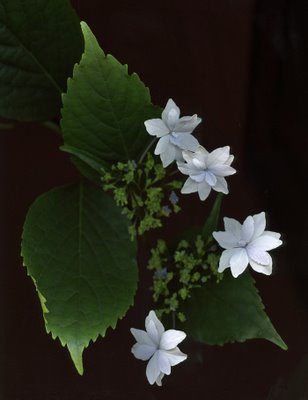 Yesterday, Saturday the girls spent the day with us. Their mother, Hilary had dinner with us and we then all retired to see and enjoy Indiana Jones And The Last Crusade. I particularly enjoyed it as I had never seen it. During our viewing I experienced the pleasure of thinking about the day and the singular opportunity that we photographers get to experience the passing of time. Here you see a picture of Rebecca posing with Hydrangea macrophylla 'Blue Wave'. When we took the picture some five years ago she chose to cross her leg as she did. The photograph instantly disturbed my wife until I explained to her that Rebecca had wanted to look like her version of an adult. Since then countless pictures without her smiling have followed and the criticism from other memebers of the family have never stopped even if they have given up in trying to pursuade me to change my technique. Lauren, unfortunately had an accident a few days ago. She fell from a tree and cut her forehead. Her other grandmother took her to emergency and her cut was "glued" together and a colourful band aid was put on. It seems that Lauren never did cry but I made the decision yesterday (I have since changed my mind) not to take her pictures with flowers and my large camera. She helped me by looking through the viewfinder (she stood on a bench) of my Mamiya. We photographed Rebecca with hydrangeas and in one case we attempted to mimic the one here. Those who are curious will have to wait until Tuesday when I will have the Ektachromes processed. I was delighted that Rebecca showed interest in the hydrangeas and she particularly demanded I photograph her with Hydrangea aspera ssp. Villosa. She appreciated the curiuous purple colour and the primitive look of the flowers but quickly changed her mind when she posed for me. The flowers covered her with pollen that itched her skin and she almost cried and told me to hurry with the photographs. There was one hydrangea I did not get to have time to photograph her with as by then she was through with me. This is the incredibly fascinating Hydrangea macrophylla 'Hanabi'. This is a Japanese cultivar and hanabi means fireworks in Japanese. I scanned a flower last night and the fertile flowers in the middle have yet to open. When they do the whole appearance of the inflorescence is of a burst of fireworks!  There is spotty information on this cultivar and the curious fact is that the best data on the plant comes from a local (Victoria) nursery called New Eden which specializes in: Representing plant breeders from throughout the world who are involved in the breeding of woody plants, vines, perennials, conifers, and small trees.
These individuals are generally small operators of wholesale nurseries from throughout the world, the one thing they all have in common is that their efforts originated with the criteria in mind to enhance the home gardeners, gardening experience.
Vin Ordinaire In My Garden
Saturday, August 02, 2008
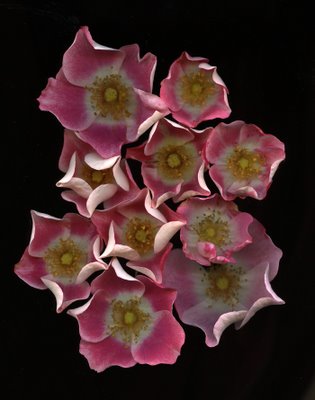 Sometimes I wonder about the French, after all they invented Champagne and the concept of high cousine. The French Meilland International Company grows some of the best roses in the world and have been doing it for at least 100 years. I would have never suspected that such a venerable company would invent the concept of roses to display in freeway medians. That's exactly what Meilland did. One of these roses, Rosa 'Pink Meidiland' never stops blooming in my garden. It never gets any diseases. It is a cast iron plant designed to survive in a city environment and thrive in spite of automobile emissions. My Pink Meidiland does not have much scent and this is perhaps its only flaw. But right now it is blooming and it is just about the only rose that is giving my cool hydrangeas (see yesterday's post) a run for their money.
The Blue Tit & The Boxing Kangaroo
Friday, August 01, 2008
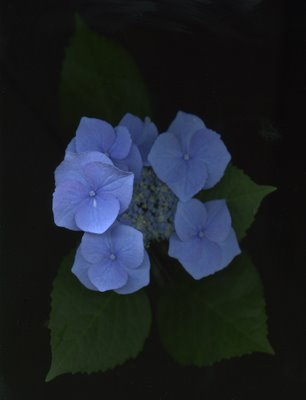 While watching a baseball game in Mexico quite a few years ago (I may have been 15) there was a fly ball out and I heard the announcer call it a braguetazo. I thought about the word and smiled. A bragueta in Spanish is a man's fly. When some Mexican with either a sense of humour or a shaky command of English translated the term fly ball he did not opt to use the Spanish verb to fly which is volar. A braguetazo would loosely translate as a powerful swat with a man's fly! I will just add here that a left fielder in Mexican baseball parlance, jardinero izquierdo, translates as left gardener. When learning English at an American School in Buenos Aires I was puzzled by many American terms including those from sports that were alien to me. One of my teachers kept using the term "life is a three ring circus". I had no concept of this. Circuses in Argentina were plentiful and all had only one ring in the middle. Why would anybody want to be distracted with more action? Particularly as my favourite circus came with a real boxing kangaroo. Since I have no editor here the above will serve as a long-winded introduction for my love of hydrangeas at this time of the year. The remontant roses are having a well deserved rest. The once bloomers are growing long canes in preparation of new wood that will be next spring's old wood and source of my favourite gallica and alba blooms. My roses, even though they are spread about in the garden, somehow seem to be a one-ring circus. When they are around their beauty and their scent prevent me from noticing anything else. With them gone I look around as if I were in a three ringer and I notice all those dark corners and the wonderful deep blue hydrangeas with their clean, crisp and mostly serrated leaves. They are disease free and they don't have to be deadheaded. I must simply make sure they get adequate watering as they are the shrubs in the garden to suffer a drought. Today, tired from my last 6-hour class (editorial photography) at Van Arts I walked around the garden with Lauren and I enjoyed the calming coolness of the blue hydranges. The bluest of them all is Hydrangea macrophylla 'Blaumaise'. It is a hydrangea developed in the 60s in Wädenswil, Switzerland and it is one of several called Teller series. It seems that teller is German for plate and the Germans and the Swiss do not call lacecaps, lacecaps. but plates! The Teller series are all named after German or Swiss birds so my very blue hydrangea is Blue Tit in English. As I walk around, my head turns and I imagine I am in that three-ring circus I never saw but somehow the vision fades and I remember why Argentines call bad music, circus band music and that cute kangaroo that was the undefeated champion in my circus book of favourites.
|



















